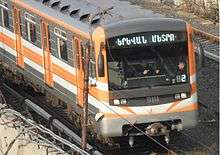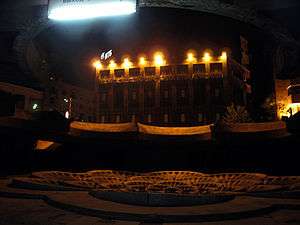Yerevan Metro
 | ||||||||||||||||||||||||||||||||||||||||||||||||||||||||||||||||||||||||||||||||||||
| Overview | ||||||||||||||||||||||||||||||||||||||||||||||||||||||||||||||||||||||||||||||||||||
|---|---|---|---|---|---|---|---|---|---|---|---|---|---|---|---|---|---|---|---|---|---|---|---|---|---|---|---|---|---|---|---|---|---|---|---|---|---|---|---|---|---|---|---|---|---|---|---|---|---|---|---|---|---|---|---|---|---|---|---|---|---|---|---|---|---|---|---|---|---|---|---|---|---|---|---|---|---|---|---|---|---|---|---|---|
| Native name | Երևանի մետրոպոլիտեն | |||||||||||||||||||||||||||||||||||||||||||||||||||||||||||||||||||||||||||||||||||
| Locale | Yerevan, Armenia | |||||||||||||||||||||||||||||||||||||||||||||||||||||||||||||||||||||||||||||||||||
| Transit type | Rapid transit | |||||||||||||||||||||||||||||||||||||||||||||||||||||||||||||||||||||||||||||||||||
| Number of lines | 1[1] | |||||||||||||||||||||||||||||||||||||||||||||||||||||||||||||||||||||||||||||||||||
| Number of stations | 10[1] | |||||||||||||||||||||||||||||||||||||||||||||||||||||||||||||||||||||||||||||||||||
| Website | http://www.yerevan.am/en/metro/ | |||||||||||||||||||||||||||||||||||||||||||||||||||||||||||||||||||||||||||||||||||
| Operation | ||||||||||||||||||||||||||||||||||||||||||||||||||||||||||||||||||||||||||||||||||||
| Began operation | 1981[1] | |||||||||||||||||||||||||||||||||||||||||||||||||||||||||||||||||||||||||||||||||||
| Operator(s) | Ministry of Transport and Communication of Armenia | |||||||||||||||||||||||||||||||||||||||||||||||||||||||||||||||||||||||||||||||||||
| Number of vehicles | 70 (2 Carriages per Trainset) | |||||||||||||||||||||||||||||||||||||||||||||||||||||||||||||||||||||||||||||||||||
| Technical | ||||||||||||||||||||||||||||||||||||||||||||||||||||||||||||||||||||||||||||||||||||
| System length | 13.4 km (8.3 mi)[1] | |||||||||||||||||||||||||||||||||||||||||||||||||||||||||||||||||||||||||||||||||||
| Track gauge | 1,524 mm (5 ft) | |||||||||||||||||||||||||||||||||||||||||||||||||||||||||||||||||||||||||||||||||||
| Electrification | Third rail, 825V DC | |||||||||||||||||||||||||||||||||||||||||||||||||||||||||||||||||||||||||||||||||||
| Top speed | 90 km/h (56 mph) | |||||||||||||||||||||||||||||||||||||||||||||||||||||||||||||||||||||||||||||||||||
| ||||||||||||||||||||||||||||||||||||||||||||||||||||||||||||||||||||||||||||||||||||

The Yerevan Metro (Armenian: Երևանի մետրոպոլիտեն, Yerevani metropoliten; since December 1999, Կարեն Դեմիրճյանի անվան Երևանի մետրոպոլիտեն (Karen Demirchyani anvan Yerevani metropoliten), the Karen Demirchyan Yerevan Metro) is a rapid transit system that serves the capital of Armenia, Yerevan. The system was launched in 1981 and like most former Soviet Metros, its stations are very deep (20-70 meters underground) and intricately decorated with national motifs. The metro runs on a 13.4 kilometres (8.3 mi)[1] line and currently serves 10 active stations. The use of the system by the city's population has dramatically declined in recent years as a result of the introduction of a new minibus system.
History

Yerevan, the capital of Armenia, experienced substantial growth during the postwar period when it was the capital of the Armenian SSR. Due to the city's very uneven landscape only an underground system could meet all of the criteria to efficiently move large numbers of people around the city. The first plans for a rapid transit system began to be formed in the late 1960s, under the auspice of Anton Kochinyan, then the 1st secretary of the Communist Party of Armenia. Initially this was centred on a rapid tram system, rather than a full underground metro system. During this time, the Soviet City Engineering Planning Department clearly stated that a Metro system would only be awarded to cities with more than a population of one million, which Yerevan lacked at the start of construction (1972). Nevertheless, all of the tunnels in which the tram lines were to be installed were built to a design that would have allowed a potential conversion into a full underground metro system.
By the end of 1978 over 4 km (2.5 miles) of tunnels were already bored through, when the plans were redesigned so that the system would be opened as a full underground metro (although to avoid extra bureaucratic measures the system continued to be officially called "Rapid Tram" right up until its opening).
There is an anecdotal version of how the Soviet rules (more than 1 million, a full Metro system; less than million, a Tram system) were bypassed. Reportedly the Chairman of the Armenian Communist Party, Karen Demirchyan, convinced the Soviet premier Leonid Brezhnev in the following manner:
| “ | Technical problems with the construction of the Rapid Tram were allowed during planning when calculations were done about perspective passenger traffic. The root of which lies in the hearts of the Armenian people. Each Armenian who lives away from his or her parents must visit them daily. As a result the passenger flow will be at least 1.5 times greater than projected. Moreover the republic is growing and becoming more developed at an increasingly large amount, sooner or later many of the Armenian diaspora (which outnumber those living in the former Armenian SSR) will want to return home. In this case, by 2000 our capital will not have 1.5 million, but 2 million inhabitants. We need Metro! | ” |
In fact, as of 2012, Yerevan has an actual population of just over 1 million.
On 7 March 1981 the system was triumphantly opened, becoming the eighth Soviet Metro system, with a first four station stage of 7.6 kilometres. Since then, the system has grown to a 13.4 kilometres (8.3 mi),[1] 10 station network.
The engineering work was of such high quality that during the 1988 Armenian earthquake the Metro managed to withstand the earthquake which paralyzed the whole republic and continued to operate on the next day with only minor damage. However this did put an end to most of the extension projects as finances were diverted to reconstruction of the destroyed infrastructure elsewhere in Yerevan and Armenia.
On 28 December 1999, the Metro was named after Karen Demirchyan, the man who was responsible for changing the status of the Rapid Tram system into becoming a Metro system, after he was killed two months earlier in a terrorist attack on the Armenian parliament.
N.B Shengavit-Charbakh route is operated as a separate shuttle service.
Timeline
| Line | Segment | Date opened |
|---|---|---|
| 1 | Barekamutyun–David of Sasun | 8 March 1981 |
| 1 | David of Sasun–Gortsaranain | 11 July 1983 |
| 1 | Gortsaranain–Shengavit | 26 December 1985 |
| 1 | Shengavit–Garegin Nzhdeh Square | 4 January 1987 |
| 1 | Shengavit–Charbakh | 26 December 1996 |
Name changes
| Station | Previous name(s) | Years |
|---|---|---|
| Marshal Baghramyan | Saralandzhi | 1981–1982 |
| Republic Square | Lenin Square | 1981–1992 |
| Garegin Nzhdeh Square | Spandaryan Square | 1987–1992 |
| General Andranik | Hoktemberyan | 1989–1990 |
Facts and numbers

Today the metro operates as a single line, with a shuttle branch and covers 13.4 kilometres (8.3 mi),[1] with trains running every five minutes from 6:30 a.m. till 11 p.m. It served about 60,000 passengers per day before a fare increase,[2] In 2012, 14.9 million passengers rode the metro.[3] but ridership fell by almost 20% to 50,000 passengers per day after the doubling of the fare.[4] The system employs about 1,200 workers. A peculiar feature of the metro is that the digital timers/clocks count up, i.e. they reset to "00:00" when a train departs, and keep counting up until the next train leaves. It is necessary for passengers to be aware that trains, in general, arrive/depart every 5 minutes or so.
Due to Yerevan's uneven landscape, the metro in some cases goes above ground. Of the ten stations; seven are underground of which one is a single-vault shallow level, and the rest are pylon deep-level stations. Continuing the tradition of all ex-Soviet underground systems, most of the stations are exquisitely decorated, often blending Armenian national motifs with late-Soviet architecture.
When the system opened it initially had no depot, and service bays in the reversal sidings were used to make minor repairs instead. The proper depot Charbakh was opened in 1985 as part of the second extension. In the early 1990s the metro system had a total of 70 cars (all of them 81-717/714 models) forming approximately 12 three-carriage trains. However, since then the intermediate carriages were sold to the Moscow and Saint-Petersburg systems in return for overhaul repairs on the driving cars (which Charbakh has no facility or apparatus to perform).
In 2000-2001, for economic reasons, all of the intermediate 81-714 carriages stopped operating and the system currently has only 13 81-717 two-carriage trains running, (12 on the main line, one on the shuttle service). The annual budget for Yerevan Metro in 2002 was 1 billion 440 million drams (about $2.5 million). Of this amount about 800 million drams was financed by the State. The rest of the budget was allocated from tickets costs, trade and advertisement. A ride on the Yerevan Metro currently costs 100 drams (about 25 cents).[2]
In 2012-2014 81-717 carriages will be refurbished. After the refurbishment trains will get the same exterior and interior as the 81-71M trains in Prague.
Plans

Despite the optimism of the growing city (which did reach one million in 1986), today the Metro is underfunded and does not form the main transport artery of the city. It has had practically no extensions since 1989 (albeit a small shuttle service to a single-platform station in Charbakh). In the city budget, which is still having to make provisions for the repair of the damage done in the horrendous 1988 earthquake, the metro clearly lacks any priority. All of the major works started in the late 1980s are currently frozen.
Moreover, since the Metro did not manage to connect the important residential districts before the earthquake and the economic crises that took place following the nation's declaration of independence, minibus routes currently have taken over as the backbone of Yerevan's urban transport, often doubling the Metro routes. In 2004 the annual ridership numbers were only 12.1 million, one of the lowest in the world. The next extension will be to the Achapnyak and Nazarbekyan stations (construction of which has been frozen since the early 1990s).
Although with the current building progress the future is very distant, there are plans for a second and third lines to eventually open, forming a typical Soviet triangle design layout of six radii, intersecting in the city centre. It was reported in March 2013 that city officials were approaching banks to seek loans for an expansion of the Yerevan Metro system.[1]
The Yerevan Metro will be thoroughly renovated for the first time since its founding 30 years ago, with funds of about $41 million allotted by the European Union. A drainage system construction, one of the preconditions for the subway’s security will be done first. The renovation is to be fully finished by 2012.[4]
See also
References
- 1 2 3 4 5 6 7 8 "Yerevan authorities negotiating new metro line projects with banks". ArmeniaNow.com. 27 March 2013. Retrieved 2013-08-04.
- 1 2 "Union of consumers: Doubled fare for Yerevan Metro will reduce number of passengers". ArmeniaNow.com. 22 June 2011. Retrieved 2013-08-04.
- ↑ "[unknown]" (PDF) (in Armenian). Retrieved 2013-08-04.
- 1 2 "Investing deep: Yerevan Metro gets continued assistance from European donors". ArmeniaNow.com. 5 December 2012. Retrieved 2013-08-04.
External links
Media related to Underground of Yerevan at Wikimedia Commons
| Wikivoyage has a travel guide for Yerevan. |
- Yerevan Metro Track Map
- Yerevan at UrbanRail.net
- Yerevan at Metroworld
- Yerevan at Metrosoyuza
- Yeritasardakan Metro 3D model
- UrbanRail.Net – descriptions of all metro systems in the world, each with a schematic map showing all stations.